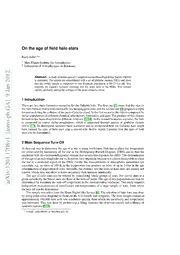
On the age of field halo stars (Jofre & Weiss, 2011) PDF
Preview On the age of field halo stars (Jofre & Weiss, 2011)
On the age of field halo stars PaulaJofre´1,2,a 1 MaxPlanckInstituteforAstrophysics 2 Laboratoired’AstrophysiquedeBordeaux 2 1 0 Abstract. AstudyofstellaragesofasamplefromtheSloanDigitalSkySurvey(SDSS) 2 ispresented.Theresultsareconsolidatedwithasetofglobularclusters(GCs)andshow thatthisstellarsampleiscomposedbyonedominantpopulationof10-12Gyrold.This n supports the Eggen’s scenario claiming that the inner halo of the Milky Way formed a rapidly,probablyduringthecollapseoftheproto-Galacticcloud. J 9 1 Introduction ] A TherearetwomainformationscenariosfortheGalactichalo.Thefirstone[1]statesthatthestarsin G thehaloformedslowlyandchaoticallyviamergingprocessesandthesecondone[5]proposesarapid . formationduringthecollapseoftheproto-Galacticcloud.Inthefirstscenario,thehaloiscomposedby h p stellarpopulationsofdifferentchemicalabundances,kinematicsandages.Theproductofthischaotic - formationhasbeenobservedviadifferentevidence[2,3,4].Inthesecondformationscenario,thehalo o is composed by coeval stellar populations, which is supported through studies of globular clusters r t (GCs) [17]. To distinguish between these scenarios and to understand how the Galactic halo might s have formedthe ages of field stars play a crucialrole. In this report,I presenthow the ages of field a [ starscanbedetermined. 1 v 2 Main Sequence Turn-Off 8 0 A classical way todeterminetheage ofa star isusingisochrones.Onehasto placethe temperature 7 (or color) and the luminosity of the star in the Hertzsprung-RussellDiagram (HRD) and to find the 1 isochronewiththecorrespondingmetalcontentthatcrossesthisregionintheHRD.Thedetermination . 1 oftheageofanindividualhalostaris,however,veryuncertainbecauseitisalmostimpossibletoplace 0 the star in a restricted region of the HRD. Firstly, the measurements of atmospheric parametersare 2 uncertain, e.g. an error of 100 K in the temperature can produce an error of up to 2 Gyr in the age 1 determinationofpopulationIIstars.Secondly,thedistanceandthemassofhalostarsareusuallynot : v known,whichdoesnotallowtoknowaccuratelytheirintrinsicluminosity. Xi The age of halo stars can be studied by considering whole groupsof stars. For coeval stars at a givenmetallicity,thebluestonesarethoseattheturn-offpoint.Theageofthispopulationcanthenbe r a determinedbymatchingtheturn-offtemperaturetothecorrespondingisochrone.Thisstudyrequires independentmeasurementsof metallicities and temperaturesof a large sample of stars, from where theturn-offcanbedetermined. ThesamplewastakenfromtheSloanDigitalSkySurvey[6].Theselectionofhalostarswasdone byusingcolor-colordiagramstofocusontheF-Gdwarfsandsubgiants.Thefinalsamplecontained approximately100,000starswithlow-resolutionspectra,fromwhichthemetallicityandtemperature was estimated. This was doneby performinga fitting between the observedspectra anda library of syntheticspectra[9,10]. a e-mail:[email protected] EPJWebofConferences Fig.1.Metallicitiesandcolorsofasampleoffieldhalostars.Redasterisksaretheturn-offcolorandmetallicities of globular clusters observed with sloan colors. Blue line is correspond to the turn-off color as a function of metallicityofthefieldpopulation,withthedashedlinerepresentingtheerror. Inacoevalstellarpopulationofagivenmetallicity,themain-sequenceturn-offshowsanedgein thetemperaturedistributionfunction.Figure1showsthemetallicityandthe(g−r)coloroftheSDSS stellar sampleusedforthisstudy.While the numberofstarsincreasessmoothlyatredcolors,atthe blue there is an abrupt decrease, which is shown with the solid line. There is a significant number ofstars bluerthanthe valuegivenbythisline. Thesestars canbe bluehorizontalbranchstars, stars of thesame age butmetal-poorer,bluestragglers,or youngerstars ofthe same metallicity.Itis also important to mention that an older population, which would have a colder turn-off color than the dominatingpopulation,maywellbehiddeninthissample.Therefore,theturn-offrepresentedbythe blueedgecanonlyestimatetheageoftheyoungestdominantpopulation. Technically,the turn-offdetectionwas performedapplyingthe Sobel Kernel[12, and references therein]tothetemperaturedistributionofthestarsatagivenmetallicityvalue.Themainingredientof thistechniqueisafirstderivativeoperatorthatcomputestherateofchangeacrossanedge,wherethe largestchangecorrespondsto theedge,i.e. theturn-off.Fordetailsontheturn-offdetectionandthe errordeterminationsee[10].ThebluelineinFig.1representstheresultoftheSobelKernelwiththe dashedlineitserror. 3 Age of the halo stars Theturn-offtemperatureasafunctionofmetallicitywasusedtolookforthecorrespondingisochrone. Itisimportanttoremarkthattheabsoluteagedeterminedonlyfromtheturn-offtemperatureisvery sensitive to the effects of gravitational setting [13,14]. Here I show only the results obtained from isochrones which include atomic diffusion of the Garching Stellar Evolution Code [15]. For an ex- tensive discussion see [10]. The age as a function of metallicity is illustrated in Figure 2, were no significantagegradientisobtainedwhenconsideringtheerrors. 3.1 GlobularClusters AstracersoftheGalaxy,GCscanbetreatedassinglestellarpopulationsandtheiragesareknownwith betterconfidencethanthoseoffieldstars.Forthisreason,asampleofGCswithugrizphotometry[16] wasusedto consolidatetheresultsobtainedforthefield stars. TheSobelKerneltechniquewasalso appliedtothe (g−r) colordistributionoftheGCstarsinthe samewayasforthe fieldstars, whose blueedgeis plottedin the diagramofFigure1 with asterisks. GCandfield starshavesame turn-off AssemblingthePuzzleoftheMilkyWay Fig.2.Theageasafunctionofmetallicityofthedominanthalo-fieldpopulation color as a function of metallicity, implyingthat absolute ages should be the same too. The study of the absolute age of 55 GCs [17], in which 7 clusters overlap with the sample of GCs of this study, concludethattheyare10-12Gyrold,showingnogradientofageasafunctionofmetallicity. Figure 3 shows the color distribution of an example GC together with the color distribution of the field stars with the correspondingcluster metallicity.Guidedby the color-magnitudediagramof the cluster,the turn-offpointis representedbythe majorpeak in thedistribution.Thesecondminor peaktowardsredcoloris producedbythestarsatthe baseof theredgiantbranch.Sincebothcolor distributionshavesimilar shapes, andsince globularclustersarecomposedby coevalstars, the field starsoftheinnerhaloprovidedbySDSSmustbelongtoonedominantcoevalpopulation.Moreover, sincetheturn-offcoloristhesameforthefieldandtheclusters,fieldandclusterstarsmustbecoeval toeachother. 4 Discussion Sincethisworkusesthe independentmeasurementsofspectroscopictemperaturesandmetallicities, thestellarsampleiscomposedmostlybythosebelongingtotheinnerhalo.Theabsenceofagradient asafunctionofmetallicityfoundforthissample(seeFig.2)hintsthatthereisonedominantpopulation ofstarsintheinnerhalo,wherethestarformationprocesstookplace10-12Gyrago. Inaddition,thereisempiricalevidencethatclusterandfieldstarssharea similarhistoryandare composedofadominantpopulation.ThecolorsofsampleofclustersobservedwithSDSS[16]were comparedtothoseofthefieldstars,whereitwasshownthatbothcolordistributionsagreedespecially intheturn-offcolorasafunctionofmetallicity(seeFig.3).Theagreementbetweentheagesforthe fieldforGCs[17]servesasafurtherargumentthatthemajorityofinnerhalostarsare10-12Gyrold. Anolddominatingpopulationfortheinnerhalogivesevidenceofarapidformationofthehaloduring thecollapseoftheproto-Galacticgas.ThisscenarioagreeswithconclusionsfromGCstudies[17,18], where the metal-poorclusters are coeval.Moreover,the absolute ages obtainedfor the clusters [17] arealso10-12Gyr,whichimpliesthatGCsandfieldstarsarecoevaltoeachother. Inthestellarsampleconsideredherethereisasignificantnumberofstarswithbluercolorsthanthe colorcut-offofthemainsequenceturn-off(seeFig.1).Theyhavealsobeennoticedinsimilarworks [19, and references therein]. An interesting explanation for them is that they were formed in small externalgalaxiesandhavebeenaccretedlaterontotheMilkyWayhalo.Thesegalaxiesexperiencea differentstar formationhistoryto the Milky Way and thereforecan be youngerthan the dominating populationof field stars. Further analysis of their kinematicsand chemicalabundancesis needed to provethisscenario.Thesebluestarsandtheexistenceofadominantpopulationofhalostarssuggest thatthetworivalingformationscenariosoftheGalactichalo[1,5]actuallycomplete,inacomposed manner,thepictureofhowtheMilkyWaymighthaveformed.Thesescenarioscombinedproposethat EPJWebofConferences Fig.3.Upperpanel:Color-magnitudediagramofanexampleclusterwithugrizphotometry.Lowerpanel:color distributionoftheclusterstars(dashedline)comparedwiththecolordistributionofthefieldstarswiththecluster metallicity(solidline) partofthehalohascollapsedrapidly,whiletheotherparthasbeenpopulatedthroughcollisionsand mergersbetweenthesatellitegalaxiesandourMilkyWay. References 1. Searle,L.&Sinn,R.,ApJ225,(1978)357 2. Belokurov,V.,Zucker,D.B.,Evans,N.W.,etal,ApJ642,(2006)137B 3. Watkins,L.L.,Evans,N.W.,Belokurov,V.,etal,MNRAS398,(2009)1757W 4. Tolstoy,E.,Hill,V.,Tosi,M.,ARA&A47,(2009)371T 5. Eggen,O.J.,Lynden-Bell,D.,&Sandage,A.R.,ApJ136,(1962)748 6. York,D.G.,Adelman,J.,Anderson,Jr.,J.E.,etal.,AJ120,(2000)1579 7. Abazajianetal.,K.N.,ApJS182,(2009)543 8. Yanny,B.,Rockosi,C.,Newberg,H.J.,etal.,AJ137,(2009)4377 9. Jofre´,P.,Panter,B.,Hansen,C.J.,&Weiss,A.,A&A517,(2010)A57 10. Jofre´,P.,&Weiss,A.,A&A533,(2011)59J 11. Preston,G.W.&Sneden,C.,AJ120,(2000)1014 12. Tabur,V.,Kiss,L.L.,&Bedding,T.R.,ApJL703,(2009)L72 13. Chaboyer,B., Deliyannis,C. P., Demarque,P., Pinsonneault,M. H., & Sarajedini, A., ApJ388, (1992a)372 14. Salaris,M.,&Weiss,A.,ASPC245,(2001)367S 15. Weiss,A.&Schlattl,H.,ApS&SS316,(2008)99 16. An,D.,Johnson,J.A.,Clem,J.L.,etal.,ApJS179,(2008)326 17. Salaris,M.&Weiss,A.,A&A388,(2002)492 18. Sarajedini,A.,Chaboyer,B.,&Demarque,P.,PASP109,(1997)1321 19. Schuster,W.J.,Moitinho,A.,Ma´rquez,A.,Parrao,L.,&Covarrubias,E.,A&A445,(2006)939
